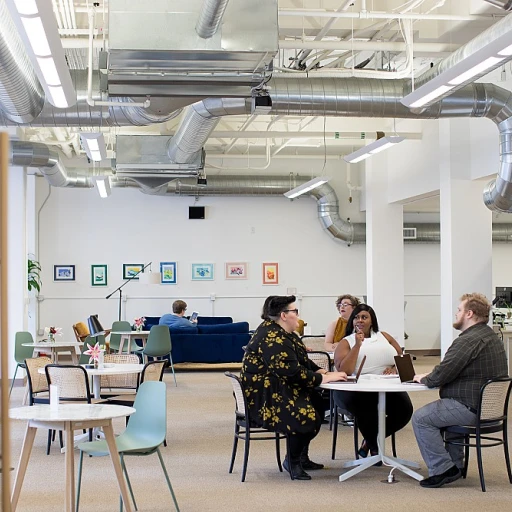-teaser.webp)
Understanding the Importance of Career Development
The Vital Role of Career Development in Today's Workforce
In today’s competitive job market, career development plays an essential role in both organizational success and employee satisfaction. The pursuit of continuous growth not only aids in honing employees’ skills but also aligns their professional development with the organization’s objectives. This ensures that employees are not limited in their current roles but are constantly presented with opportunities for career growth. Companies that invest in robust career development programs often see substantial benefits. These programs can enhance workforce productivity, improve employee engagement, and contribute to lower turnover rates. Moreover, organizations that prioritize development initiatives demonstrate a commitment to their workforce, fostering a positive company culture where employees feel valued and motivated. For employees, understanding how their career paths can evolve within the organization is crucial. It provides a clear view of possible progression and helps in setting both short-term and long-term career goals. This approach not only makes their job more fulfilling but also encourages a high level of dedication and performance. Furthermore, offering structured career development frameworks can also play a pivotal role in succession planning, ensuring that the organization has a pipeline of competent leaders ready to step into critical roles when needed. This foresight is vital for maintaining business continuity and fostering an environment of innovation and leadership. Providing learning opportunities through professional development programs, training sessions, and mentorship can empower employees to achieve their professional objectives. Empowering Women Through Leadership Conferences is a notable example of how targeted development programs can elevate specific groups within the workforce, thus promoting diversity and inclusion. Ultimately, effective career development is not an isolated initiative. It integrates seamlessly with other aspects of human resources, aligning with organizational needs and fueling the long-term vision of the company.Identifying Organizational Needs and Goals
Aligning Career Development with Organizational Objectives
To craft effective career development programs, it's crucial to first understand the specific needs and goals of your organization. This alignment ensures that the development initiatives not only support employee growth but also contribute to the company's overall success. Identifying these organizational needs involves a thorough analysis of both current and future objectives, which can guide the creation of tailored development plans.
Assessing Current Workforce Capabilities
Begin by evaluating the current skills and capabilities of your employees. This assessment helps in identifying gaps between existing competencies and those required to meet the company's strategic goals. By understanding these gaps, organizations can design targeted training programs and learning opportunities that address specific needs, fostering both short-term and long-term career growth.
Engaging Leadership in Development Initiatives
Leadership plays a pivotal role in the success of career development programs. Engaging leaders in the planning process ensures that the development goals align with the company's vision and mission. Leaders can provide valuable insights into the skills and competencies that are essential for achieving organizational objectives, helping to shape effective development plans.
Creating a Culture of Continuous Learning
Organizations should strive to create a culture that encourages continuous learning and professional development. This involves offering a variety of learning opportunities, such as workshops, seminars, and online courses, which can help employees enhance their skills and advance their career paths. By fostering a supportive environment, companies can motivate employees to actively participate in their own development journey.
For more insights on aligning career development with organizational goals, consider exploring crafting effective strategies for high-performance teams.
Designing a Comprehensive Career Development Framework
Creating Structured Development Pathways
Designing a comprehensive career development framework is pivotal for aligning employee growth with organizational objectives. A well-crafted plan integrates structured career paths and development plans that not only meet employee career goals but also bolster the company's long-term success. It’s vital for an organization to recognize that career planning is not a one-size-fits-all approach but rather a tailored experience catering to individual skills and aspirations.
Establishing a roadmap involves several components:
- Profiling Job Roles: Assess the skills and competencies required for each role within the company. Understanding the current landscape allows for effective succession planning and aids in crafting growth plans for employees.
- Aligning Organisation Goals: Integrate the overarching organizational goals into career development programs. This ensures that as employees advance through their career growth, they are contributing to the larger objectives of the company.
- Customized Career Pathways: Develop personalized career paths that leverage the strengths of employees, catering to long-term and short-term development goals. Fostering a sense of direction can enhance employee engagement and professional satisfaction.
- Incorporating Learning Opportunities: Embed diverse learning opportunities like training programs and workshops that are aligned with career goals. Strategic scheduling of these activities can help employees effectively climb their career paths.
By implementing these strategies, organizations lay a solid foundation that not only guides employee development but also propels the company towards sustained success. For more insights on launching successful development initiatives, consider exploring this guide.
Implementing Effective Training and Mentorship Programs
Enabling Growth Through Structured Learning Paths
Implementing effective training and mentorship programs is crucial for fostering employee growth and achieving organizational goals. Within a well-designed career development framework, these programs serve as foundational pillars, offering employees the tools they need to advance their skills and reach their career goals.
Training programs should be tailored to align with both organizational needs and individual career paths. This alignment ensures that employees gain relevant skills, enabling them to contribute more effectively to the company's long term success. A comprehensive development plan should include:
- Varied Learning Opportunities: Offer a mix of in-person workshops, online courses, and on-the-job training to cater to different learning styles and preferences. This diverse approach can help employees enhance their professional development and better prepare for future roles within the organization.
- Clear Progression Plans: Clearly defined career paths and advancement opportunities can motivate employees to pursue specific professional development goals. Establishing short term and long term development goals will help employees map out their career growth within the company.
- Leadership Development Programs: Nurturing potential leaders through targeted programs can benefit succession planning efforts, ensuring that future leaders are ready to step into key positions when needed.
- Strong Mentorship Networks: Connecting employees with experienced mentors can provide vital support and guidance. Mentors can share insights, offer feedback, and help navigate the challenges faced by employees on their career journeys.
An effective employee development strategy should also incorporate regular assessments and adjustments based on feedback. Constant evaluation of training programs ensures they remain relevant and impactful, ultimately helping employees and the organization achieve their respective goals.














